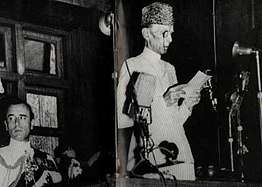Constituent Assembly of Pakistan
The Constituent Assembly of Pakistan (Bengali: পাকিস্তান গণপরিষদ, romanized: Pākistān Goṇoporishod; Urdu: آئین ساز اسمبلی, romanized: Aāin Sāz Asimblī), was formed to write Pakistan's constitution and serve as its first parliament.
Constituent Assembly of Pakistan آئین ساز اسمبلی, | |
|---|---|
.svg.png) | |
| History | |
| Founded | 11 August 1947 |
| Succeeded by | Islamic Republic of Pakistan |
| Leadership | |
President | |
| Seats | 96 |
| Meeting place | |
| Karachi | |
First Session
Pakistan's Constituent Assembly first convened on August 11, 1947, on the eve of independence and the end of British rule. Muhammad Ali Jinnah remained its president until his death on September 11, 1948. Subsequently, Liaquat Ali Khan headed it for three years and produced the Objectives Resolution, which was adopted by the Constituent Assembly in 1949 as an annex to Pakistan's constitution. It is important to mention that 21 members out of 69 voted for the Objectives Resolution. The assembly had a majority of Muslim League members, with the Pakistan National Congress, the successor to the INC in the state, forming the second largest party.
The assembly was widely criticized for its incompetence. Addressing a rally in Lahore on October 14, 1950, Maulana Maududi demanded its dissolution, arguing that the "lampost legislators" were incapable of drawing up an Islamic constitution. Huseyn Shaheed Suhrawardy said that assembly did not possess any of the characteristics of a democratic parliament. He argued that the nation would overlook any unconstitutional action on the governor general's part if he exorcised the fascist demon and established representative institutions.[1]
In contrast, the Constituent Assembly of India, which had more diversity, took less than two and a half years to draw up the Constitution of India. The Indian constitution was promulgated on January 26, 1950, and first general elections were held in 1952.[2]

The Constituent Assembly of Pakistan was dissolved on October 24, 1954, by Governor General Malik Ghulam Muhammad. The dissolution was challenged by the president of the assembly in the notable case of Federation of Pakistan v. Maulvi Tamizuddin Khan, in which the federal court took the side of the governor general, in spite of dissent from one judge. Mohammad Ali Bogra was the Prime Minister of Pakistan at the time.[3]
Second Session
The second Constituent Assembly reconstituted on May 28, 1955. The constitution was promulgated on March 23, 1956, and Pakistan became an Islamic republic. On October 7, 1958, martial law was imposed on the country by Iskander Mirza. The new powers abrogated the constitution, declaring it unworkable.
After coming to power, Zulfikar Ali Bhutto invited the leaders of the parliamentary parties to meet him on October 17, 1972, which resulted in an agreement known as the 'constitutional accord', after an intensive discussion. As per consultations floated by the PPP, the National Assembly of Pakistan appointed a 25-member committee, on April 17, 1972, to prepare a draft of the permanent constitution of Pakistan. Mahmud Ali Kasuri was the elected chairman of the committee. On October 20, 1972, the draft bill for the constitution was signed by leaders of all parliamentary groups in the National Assembly. A bill to provide a constitution for the Islamic Republic of Pakistan was introduced in the assembly on February 2, 1973. The assembly passed the bill nearly unanimously on April 10, 1973 and it was endorsed by the acting President Zulfikar Ali Bhutto on April 12, 1973.[4] The constitution came into effect on August 14, 1973. On the same day, Bhutto took over as the prime minister and Choudhary Fazal-e-Elahi as the president. On July 5, 1977, General Zia staged a military coup and suspended the constitution, which was restored in 1985. Similarly, when General Musharraf took over in 1999, the constitution was suspended for several years.
See also
References
- Inamur Rehman, Public Opinion and Political Development in Pakistan (Karachi, Oxford, 1982)
- ^ "Introduction to Constitution of India". Ministry of Law and Justice of India. July 29, 2008.
- "National Assembly of Pakistan". www.na.gov.pk. Retrieved 2019-09-05.
- Jennifer Musa